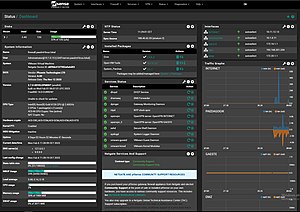pfSense is a firewall/router computer software distribution based on FreeBSD. The open source pfSense Community Edition (CE) and pfSense Plus is installed on a physical computer or a virtual machine to make a dedicated firewall/router for a network.[3] It can be configured and upgraded through a web-based interface, and requires no knowledge of the underlying FreeBSD system to manage.[4][5]
| Version of the FreeBSD operating system | |
 | |
 The main dashboard of pfSense 2.7.0-DEVELOPMENT | |
| Developer | Rubicon Communications, LLC (Netgate) |
|---|---|
| OS family | FreeBSD |
| Working state | Current |
| Source model | Closed source and open source |
| Released to manufacturing | Oct 2006 |
| Latest release | |
| Repository | |
| Platforms | 32-bit (discontinued in 2.4.x); 64-bit Intel / AMD |
| Default user interface | Web |
| License | Apache License 2.0[2] (Applies to pfSense CE) |
| Official website | pfsense |
| Support status | |
| |
Overview
The pfSense project began in 2004 as a fork of the m0n0wall project by Chris Buechler and Scott Ullrich. Its first release was in October 2006.[6] The name derives from the fact that the software uses the packet-filtering tool, PF.[7]
Notable functions of pfSense include traffic shaping, VPNs using IPsec or PPTP, captive portal, stateful firewall, network address translation, 802.1q support for VLANs, and dynamic DNS.[8] pfSense can be installed on hardware with an x86-64 processor architecture. It can also be installed on embedded hardware using Compact Flash or SD cards, or as a virtual machine.[9]
OPNsense
In January 2015, the OPNsense project was started by forking the version of pfSense at that time.[10]
In November 2017, a World Intellectual Property Organization panel found Netgate, the copyright holder of pfSense, utilized OPNsense' trademarks in bad faith to discredit OPNsense, and obligated Netgate to transfer ownership of a domain name to Deciso.[11]
WireGuard protocol support
In February 2021, pfSense CE 2.5.0 and pfSense Plus 21.02 added support for a kernel WireGuard implementation. Support for WireGuard was temporarily removed in March 2021 after implementation issues were discovered by WireGuard founder Jason Donenfeld.[12][13][14] The July 2021 release of pfSense CE 2.5.2 version re-included WireGuard.[15]
See also
References
- ^ a b "Releases — Versions of pfSense and FreeBSD". netgate.com. Retrieved 2024-02-16.
- ^ "pfSense adopts Apache 2.0 License". Serve The Home (Loyolan Ventures, LLC). 19 June 2016.
- ^ Ot, Anina (2021-02-03). "6 Reasons Why You Should Be Using pfsense Firewall". MUO.
- ^ "You should be running a pfSense firewall". InfoWorld. 22 December 2014. Retrieved 27 July 2015.
- ^ Miller, Sloan (26 June 2008). "Configure a professional firewall using pfSense". Free Software Magazine (22). Archived from the original on 3 October 2011. Retrieved 27 September 2009.
- ^ Fields, Robert (28 October 2016). "Happy 10th Anniversary to pfSense Open Source Software". Netgate Blog.
- ^ Mobily, Tony (14 August 2007). "Interview with Jeff Starkweather, Chris Buechler and Scott Ullrich". Free Software Magazine. Archived from the original on 12 September 2015. Retrieved 5 May 2020.
- ^ "pfSense® CE functions".
- ^ "How to Install pfSense Firewall on Ubuntu and CentOS?". Geekflare. 2020-02-06.
- ^ Fischer, Werner (2018-11-21). OPNsense: the "open" firewall for your datacenter. Retrieved 2024-10-11 – via media.ccc.de.
- ^ "WIPO Domain Name Decision: D2017-1828". WIPO. November 12, 2017.
- ^ Salter, Jim (2021-03-15). "In-kernel WireGuard is on its way to FreeBSD and the pfSense router". Ars Technica. Retrieved 2021-03-20.
- ^ "Releases — 21.02/21.02-p1/2.5.0 New Features and Changes". docs.netgate.com. Retrieved 2021-03-20.
- ^ Kumar, Rohit (2021-03-19). "pfSense and FreeBSD Pull Back on Kernel WireGuard Support". ServeTheHome. Retrieved 2021-03-20.
- ^ "pfSense CE 2.5.2-RELEASE Now Available". www.netgate.com.
Further reading
- Mastering pfSense, Second Edition Birmingham, UK: Packt Publishing, 2018. ISBN 978-1788993173. By David Zientra.
- Security: Manage Network Security With pfSense Firewall [Video] Birmingham, UK: Packt, 2018. ISBN 978-1789538991. By Manuj Aggarwal.